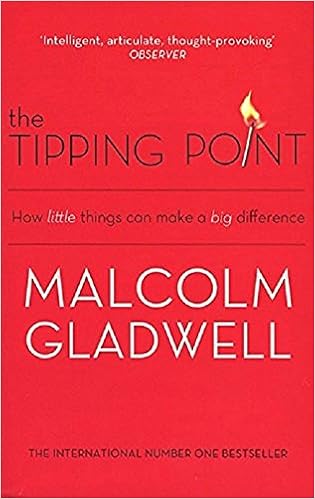The Tipping Point

Thanks to the lockdown and being at home, I
have too much time to spare, and it gives me so much happiness to devout this
time for all the things I love and care. Oh my, that rhymed! So, I have been
reading to my heart’s fill, binge watching sitcoms – especially ones adapted
from bestselling novels, and doing some experimental cooking, as in home who’s
there to judge anyway.
I have been seeking out non-fiction read that is
simple in its description and interesting enough to grasp my wavering attention
for a complete sitting. ‘The Tipping Point’ by Malcolm Gladwell is one such average
length book, that had been sitting there in my bookshelf for years. I had
bought this International Bestseller from a bookshop near a Museum in Bangalore.
(I remember this as it was my first time exploring the city of Bangalore, then.)
It talks about how little things can make a big difference, as the tagline
reads. Now we have another term for it – ‘going viral’. How social behaviors,
fashion trends, practices, ideas etc. spread like wildfire or tip off beyond
anyone’s imagination. How does anything go viral or become an epidemic, beyond
control, this being applicable to diseases as well. It’s quite a fascinating page
turner.
The book is a work of great research. The best
thing is that it connects examples from so many different areas to explain in
rather simple terms the key phenomena at play in the making of any of these viral
trends. We get to read about the events that didn’t seem of great significance
but led to the tip off moment.
“Three characteristics – one, contagiousness;
two, the fact that little causes can have big effects; and three, that change
happens not gradually but at one dramatic moment – are the same three principles
that define how measles moves through a grade-school classroom or the flu
attacks every winter. ”
As per the author, there are three reasons
behind why a particular event tips off – he names them The Law of Few, The Stickiness
Factor and The Power of Context. These are separated into chapters with so many
sociological and behavioral examples from past decades – strange events that
have resulted in numerous research studies.
The Law of Few states that it’s a courtesy of a very few
people that any idea tips off. Or we can say a very few number of people are
actually responsible for any disease tipping off to become an epidemic. We can
relate to all this more so, in our current situation of the pandemic. May be
that person who threw a party for 2k people, or the one who traveled 7
countries in seven days, etc. Remember that curve, which slowly rises and then
suddenly at some point peaks exponentially. On similar context why a TV show
gets immense popularity, or a web series for that matter. The outbreak of AIDs
and syphilis.
“Mavens are the data banks. They provide the
message. Connectors are social glue: they spread it. But there is also a select
group of people – Salesmen – with the skills to persuade us when we are unconvinced
of what we are hearing, and they are as critical to the tipping of
word-of-mouth epidemics as the other two groups.”
The Stickiness Factor tells us that there is some
strangeness or gluing factor to a thing or an event that keeps it being
repeated, makes it contagious, occurring in patterns and make it spread. Why is
yawning contagious? What makes the seasonal flu stick through winter? What
results in collective behavior? What made the TV show Sesame Street a major
success in preschoolers’ education? (This study was my personal favorite. It’s
on child’s psychology, learning process and how the TV creatives harness it to grab
their attention and teach them lessons.)
“Ya-Ya was being talked about and read in
groups, the book itself became that much stickier. It’s easier to remember and
appreciate something, after all, if you discuss it for two hours with your best
friends. It becomes a social experience, an object of conversation.”
The Power of Context is an argument that says that
behavior is a function of social context or a person’s extended environment. “When
they are away from their families – in different contexts – older siblings are
no more likely to be domineering are younger siblings no more likely to be
rebellious than anyone else.”
In a public experiment, The Stanford University
had forms up for volunteers who had to stay in a custom-made prison inside its
campus for a certain period. The
authentic prison atmosphere made the inmates depressed and aggressive in the
following days. Another incident – a shooting of two black men in a subway was
covered in all news medium for months, making it a topic for all the
conversations and research. The results suggested that it is possible to be a better
person on a clean street or in a clean subway than in one littered with trash
and graffiti. Environment affects us more than we think it does.
There was a case study on suicide epidemics in
the book too. Quite unusually interesting study.
“Suicide stories are a kind of natural advertisement
for a particular response to your problems.”
“Then somebody else does it and so I do too. It’s
a kind of imitation.”
“I don’t know whether any of us knows how much of
our decision is conscious and how much is unconscious. Human decisions are
subtle and complicated and not very well understood.”
“Through the persuasive force of his
personality, serve as a Tipping Point in a word-of-mouth epidemic, the people
who die in highly publisized suicides – whose deaths give others ‘permission’
to die – serve as the Tipping Points in suicide epidemics.”








Comments
Post a Comment